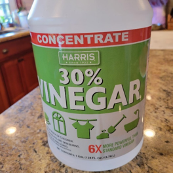
by Stan Logan | Nov 29, 2023 | Weeds
 Here is an herbicide that is safe to use in your garden—vinegar. Now, table vinegar won’t work. It has a concentration of 4-5%. You need to buy 30% vinegar which you will find at Home Depot or Lowes. The thing is, you can reduce the percentage to 20% and it will still be very effective. Dilute the 30% by adding 1 part water to 2 parts vinegar and you will get 20%. I have been testing vinegar spray at the Rock Garden and have found it to be deadly on everything but Bermuda grass. You will find that one application will kill weeds in a very short period of time.
Here is an herbicide that is safe to use in your garden—vinegar. Now, table vinegar won’t work. It has a concentration of 4-5%. You need to buy 30% vinegar which you will find at Home Depot or Lowes. The thing is, you can reduce the percentage to 20% and it will still be very effective. Dilute the 30% by adding 1 part water to 2 parts vinegar and you will get 20%. I have been testing vinegar spray at the Rock Garden and have found it to be deadly on everything but Bermuda grass. You will find that one application will kill weeds in a very short period of time.

by Stan Logan | Nov 15, 2022 | Garden tools, Safe Gardening, Weeds
If you have followed my blogs, you will remember how I have touted the benefits of controlling weeds by burning them. The main advantage is that the weed seeds are destroyed along with the weed.

My experience with weed burning has evolved over the years. The first tool I used was the small green propane tank and torch you see on the pavement in the photo below. I would walk through our garden, bend over, and press the red button to produce a flame that cooked whatever weed I found. I would use a trowel to shield drip lines or valued plants.
When I joined Daisy Mah’s crew at the WPA Rock garden, I used this torch to fry the weeds growing in the paths. This slow process led me to advance to a much bigger torch. I attached a 5 gallon propane tank to a hand truck and wheeled throughout all the Rock Garden paths. It wasn’t long before all paths were weed free.
Recently, due to back problems, I was unable to bend over to reach the weeds. So, I bought a burner with a long tube extension that allowed me to burn weeds while standing erect. This system works well except there is no button to turn the flame on and off as you move around, and the flame is much larger than that produced by the smaller torch.
Well, a month ago, I was using this long burning torch in the garden, and I quickly burned some weeds next to the fence, and then continued to work my way around the yard. I was alerted by my wife, who had been indoors, that there was an emergency. And, sure enough, flames were roaring several feet above our fence. A nearby hose finally quelled the flames, but the damage was done.
What you see in the photo is the view from my neighbor’s yard. My new torch had ignited dry material on the other side of the fence and flames quickly engulfed the redwood boards. It did not help that daytime temps were around 100 degrees. Also, had there not been an open space at the base of the fence, there would not have been any fire damage.

When I have talked about the use of a torch to control weeds, I mention the possibility of burning a fence as sort of a joke. As it turned out, the joke was on me.
Happy (but safe) burning,
Stan, The Burning Man
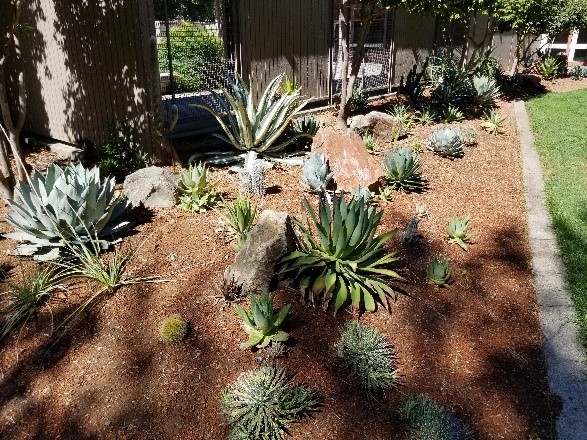
by Stan Logan | Aug 14, 2021 | Weeds
I recently drove to the Shepard to leave a set-up map of Iris Society rhizome sale for Lisa. (By the way, she is a wonderful person to work with. We are lucky to have her.) As I walked around the building to the mail slot in the front, I noticed how great a club-planted area appeared. The landscape display created by the Sacramento Cactus and Succulent Society is absolutely outstanding. They have set a really high bar. The garden out front that the Perennial Plant Club maintains is impressive too. But . . . the garden created by the Iris Club looked terrible. Magnolia leaves covered the ground, weeds were growing, and the irises needed cleaning up. You know, the money spent by the Shepard making the club signs was well worth it as there was no denying who was responsible for the mess. Whether you call it pride or peer pressure, I was embarrassed. So, several days later we gathered a work crew and cleaned up our assigned area and planted more irises. Then we spread a yard of mini bark to spruce things up. Hopefully our garden will still look good so you can appreciate it the next time you visit the Center.
Stan, The No Longer Embarrassed Man
 Succulent Society Garden |
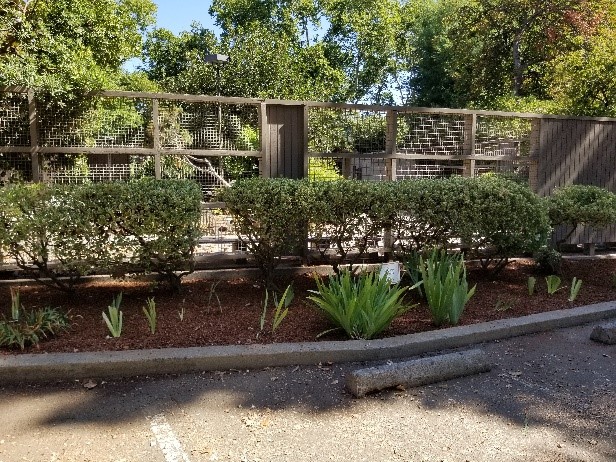 Iris Society spruced up garden |
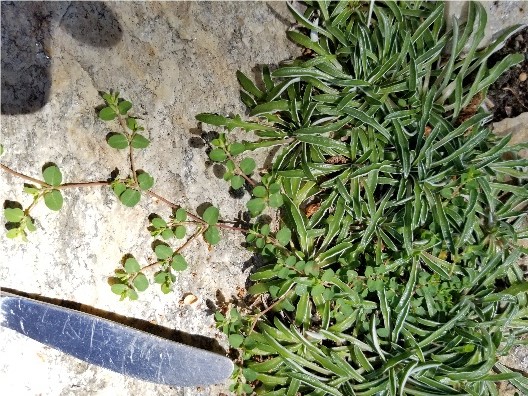
by Stan Logan | Jun 26, 2021 | Garden tools, Weeds
Somehow it is ironic—instead of me describing a tool that I feel you need, but don’t have, here is a tool that you do have, but probably don’t need. Unless you have steadfastly held onto the eating habits of your Neanderthal ancestors, I’m betting that you have at least one set of eating utensils in your home. It is the dinner knife that I am singling out this time. I have found that this is the best tool for teasing out weeds from ground cover. Now, if you don’t have ground cover, stop reading and go out to your garden and do something useful—take a flashlight if it is dark.
Since you are still reading, you must have ground cover . . or are just too pooped to crawl out to the garden again. Now the term “teasing” is a biological dissection term for the act of carefully separating the organs of small specimens with pointed tools like probes or dissecting needles. Every time I use a dinner knife to tease a weed out of desired ground cover plants, I cannot help but be reminded of my first biology dissection where I cut through the dorsal surface of a preserved earthworm and teased through the connective tissue until I found the two lobed brain and the nerve cords that led down and around the pharynx. Hmmm . . . you don’t have those same memories
Back to the garden: The way you use your knife to tease is to grab the offending weed and pull gently while you work the knife down into the root area and move it about. If you are successful, the weeds will be extracted and the ground cover will remain intact. If you are unsuccessful, the stem of the weed will break off only to regrow when you aren’t looking. Now I will be the first to admit that this is not a pleasant gardening chore. You are on you hands and knees with you nose to the ground (not literally). Even using knee pads does not appease my knees which insist on complaining for hours afterwards.
I have included 3 examples of weeding that recently required teasing in my garden. I always refer to the ground cover plants as conspiring plants as they seem to delight in hiding offensive weeds until they grow into maturity.
You know, if using grandma’s sterling dinner knife seems disrespectful, drop by a thrift store and pick up a strong stainless steel model, but watch out for impulse buying!
Stan, The Tool Man
 |
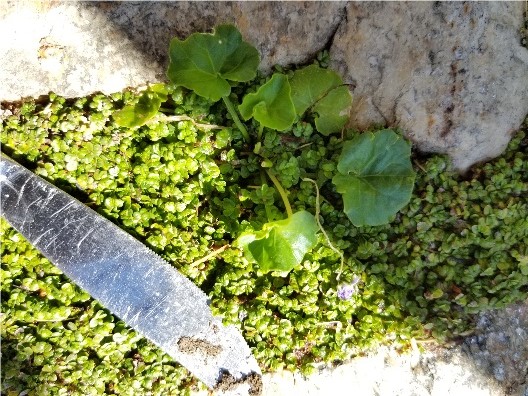 |
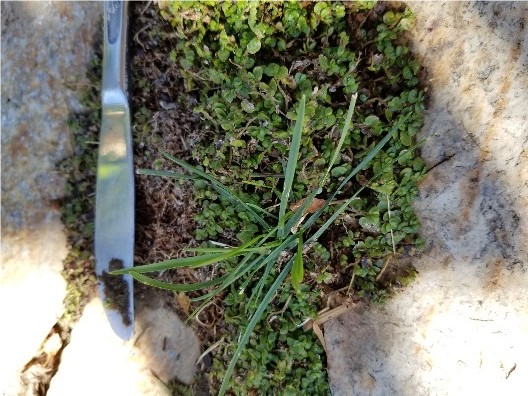 |
| Spurge in Dimondia |
Australian violets in baby tears |
Grass in baby tears |
by Stan Logan | Apr 26, 2021 | Garden tours, Weeds
LaVille and I have recently joined the weeding group working to maintain the WPA Rock Garden. We meet between 9:00 and 9:30 each Thursday and park above the Rock Garden on the road that leads to the entrance to the zoo. A finer group of volunteers you’ll never meet. The task I have chosen is to attack the weeds in the paths with a torch. Now the torch I use is the same one I use almost daily in our garden going after newly germinating moss, baby tears, and annual bluegrass. Most of the weeds I toast are less than ½ inch high, so the small torch I use produces a small, concentrated flame that adequately bakes my prey. (It’s the same torch I described in the blogs on the SPPC web site.) Like I discussed before, the problem is that I have to bend over the weeds, and unless there is a breeze, the smoke rises up into my face. I bob and weave about trying to avoid the smoke, but the days following a burning session are sometimes accompanied by irritated eyes. I tried to solve this one day at the Rock Garden by wearing googles but was discouraged by the ridicule of my wife and the fear in the eyes of children walking the paths.
I just have to stop here and tell you what a fantastic place the Rock Garden is—thanks primarily to Daisy Mah who has made the garden so special. The winding paths bordered by walls of granite boulders encompass plantings that are marvelous. It is a joy to see adults with their kids wind through the garden. Professional looking photographers seem always to be there. Families have gatherings to celebrate occasions. It is simply a happy place.
Now, back to burning weeds: Not only was the smoke in the eyes a problem, but I was pretty much exhausted after bending over for a couple hours. And, of course, I always stunk of burned weeds afterwards. My solution was to borrow a long torch from a club member. I found this really worked well as the larger flame burned weeds probably ten times faster. But also used gas ten times faster, and in 2 days I went through 2 tanks of propane gas. I wasn’t too concerned because I was used to picking up tanks and garage sales and estate sales for no more than a couple bucks. I went to the Davis Ace—no tanks. I went to Home Depot—no tanks. I went to Lowes—no tanks. That’s when I found out that backpackers grab up these tanks as soon as they come in. OK—Amazon—yes, but they’re over $11 each and would take a week to get here from the East Coast (No combustible gas aboard airlines.) So I ordered a packet of 4—but just for use with my small torch in my own garden.
My new plan is to order my own bigger torch with a 10 foot hose that will connect to one of my 20 pound propane tanks used with the barbeque. I’m going to lash it to a hand truck and roll it around the Rock Garden and hopefully eliminate all the weeds in the paths in a couple sessions. I’ll add the results to this article after next Thursday’s session.
Weeks Later – I have to tell you that I am somewhat frustrated. I can’t find any more weeds to burn in the paths for the Rock Garden, and it’s tiring dragging the hand truck with the propane tank attached through all the paths because there are raised steps involved. But the good news is that I really love my new torch. I no longer have to bend over with my small hand-held torch. Smoke no longer rises up into my face. The flame is much bigger and really hot. If I can find the same model again on Amazon, I’ll picture it below. It has a self-starter attached so I don’t have to carry around a flint starter. Until you squeeze the handle, the torch stays lit with a gentle flame. Then when you press the handle a roaring flame shoot out. The size of that flame is easily controlled by the knob right near your hand. The 12 foot hose allows you to cover a big area without moving the tank. Using a 20 pound tank is much much cheaper than using the small tanks that attach directly to the torch. Plus you can always get the big tank refilled. Good luck finding a small tank to buy when you need it.
The bad news is . . the chance that a reader of this article would ever need this torch is slim. I can’t even use this torch on my own property. Our lot is average-sized for homes built in the ‘70s and there is very little ground left where there’s no valued plant growing. Then too, bark covers what is left. I’ll probably take the torch out front and cook all the weeds growing the joints of the sidewalk and in the cracks of the poorly maintained asphalt of the street. But other than that, my little torch is a far better choice for my personal weed problems. But if you are fortunate enough to have a large property and unfortunate enough to have a huge weed problem, this is one honey of a tool for you.
Happy burning!
Stan, The Tool Man
P.S. My editor says I should mention that this is a tool only for use by responsible users who are careful enough not to burn down the State of California.
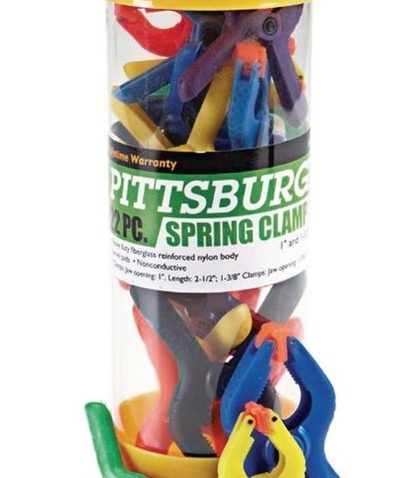
by Stan Logan | Mar 3, 2021 | Garden tools, Weeds
Once again it is beneficial to look outside the box. Here we have a versatile item that you won’t find in your local nursery. Please note that although labeled “Spring” clamps, these devices may be used during all 4 seasons—and especially in the Summer. You can see by the accompanying photo, that they are brightly colored, which will hopefully prevent their loss. (I haven’t seen your garden, but I suspect you may have the tendency to leave stuff all over.) This complete variety of color allows you to accessorize your gardening attire with clamps that will attach anywhere. I don’t have much capability, but I suppose you could even adorn your hair with these snazzy items. I tried this idea, but found it rather painful.
So how would you use these clamps in the garden? You could support plants. You wouldn’t pinch the plant itself—that would be cruel—but enclose the branch and clamp to a supportive structure. Using this on vines, tomato plants, and bougainvillea immediately comes to mind, but, really, any plant that requires staking would be a good candidate. Then there’s the need to attach sheet material—bird netting, shade cloth, frost protection, tarps. Could you use it to attach labels? How about hanging yellow sticky sheets. Maybe you need to close a bag of fertilizer. How ‘bout sticking one on your body to remind you to turn off the water.
I think you can see that there is almost no end to the uses for this versatile tool. You are probably not trying to decide whether or not to buy, but how many to buy. Well, the good news is that these clamps are really cheap. You can purchase a set of 22 clips for only $4.99 at your closest Harbor Freight, so don’t hold back!
Happy Clamping,
Stan, The Tool Man
P.S. If you really want to travel outside the box, google “clampers.” My brother-in-law is one of these.

Spring Clamps

 Here is an herbicide that is safe to use in your garden—vinegar. Now, table vinegar won’t work. It has a concentration of 4-5%. You need to buy 30% vinegar which you will find at Home Depot or Lowes. The thing is, you can reduce the percentage to 20% and it will still be very effective. Dilute the 30% by adding 1 part water to 2 parts vinegar and you will get 20%. I have been testing vinegar spray at the Rock Garden and have found it to be deadly on everything but Bermuda grass. You will find that one application will kill weeds in a very short period of time.
Here is an herbicide that is safe to use in your garden—vinegar. Now, table vinegar won’t work. It has a concentration of 4-5%. You need to buy 30% vinegar which you will find at Home Depot or Lowes. The thing is, you can reduce the percentage to 20% and it will still be very effective. Dilute the 30% by adding 1 part water to 2 parts vinegar and you will get 20%. I have been testing vinegar spray at the Rock Garden and have found it to be deadly on everything but Bermuda grass. You will find that one application will kill weeds in a very short period of time.







